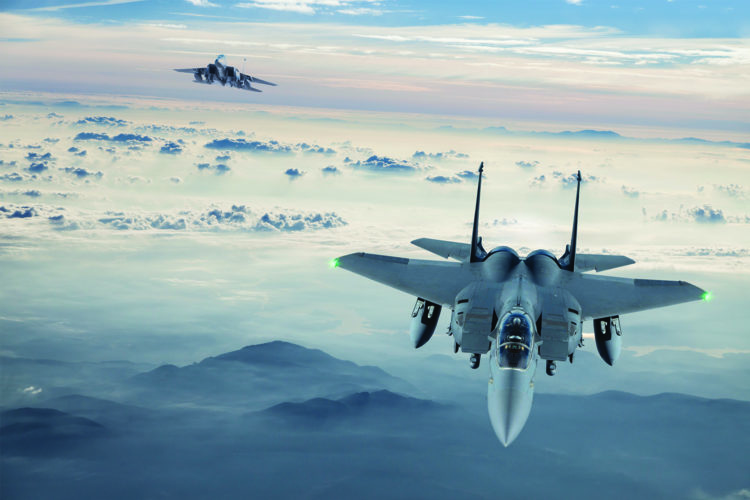
In a recent project at a major defense prime, the instrumentation team collaborated with the R&D team to build a comprehensive library of high fidelity RF data captures. Building this library was critical in maintaining their position as a leading provider of electronic warfare systems.
Problem Background
The common goal of both engineering teams was to capture real world, high fidelity RF data signals in an airborne environment. Given the cost associated with flying an aircraft, it was imperative to generate a permanent record of real-world conditions—in a single recording—for repeated playback and review. These recordings could then be distributed across all engineering teams.
To reflect the most accurate representation of these scenarios, recordings needed to be made without undesired artifacts and spurious signals. The challenge was to achieve desired outcomes within the limitations of available hardware, time constraints, and budgetary restrictions.
R&D determined that these project goals were achievable with a product designed and built from scratch; but the instrumentation team concluded that an in-house custom build was unrealistic in terms of risk and timeline.
Key Engineering Requirements
- Collaborative vendor/partner that can help analyze and define interference mitigation strategies and channel plan.
- Wide instantaneous record bandwidth (320 MHz).
- Excellent dynamic range with low noise amplification and rejection of strong, undesired signals.
- Extremely wide tuning bandwidth (50 MHz to 18 GHz).
Discovering the Solution
Both engineering teams sought to balance custom design risks with the practicality of standard hardware. The challenge was addressed by combining off-the-shelf recording hardware with custom signal processing components which could reject large interfering signals and amplify weak desired signals.
The high fidelity solution they discovered was four-fold:
- RF Recorder Spectrum Defender® Model SD-3823 with high bandwidth and extremely wide frequency range.
- Underbelly filtered LNA assembly custom design for exceptional dynamic range, amplification, and filtering of the weakest signals.
- Switched filter bank preselector assembly with complex filter bank to reject large undesired signals.
- Underbelly antenna assembly provided by customer.
The baseline RF performance of the off-the-shelf recorder was determined through both analysis of data sheet specifications and performance tests in a controlled lab environment. In cases where analysis and lab tests did not yield the desired insight, Spectra Lab provided access to the National Instruments design team to predict interference rejection performance.
Before committing to the flight, the engineering team compared the predicted recorder performance against Spectra Lab’s 19 years of real-world observations and experience. The R&D and instrumentation teams delivered a solution that met the RF performance, environmental extremes, and aircraft integration requirements.
Spectrum Defender® Provides a Platform to Accept Adaptations For Optimal Fidelity
The engineering teams found a high fidelity RF recorder that could be further adapted to reject extremely large undesired signals and amplify extremely weak desired signals. Spectrum Defender provided a platform to accept adaptations for optimal fidelity.
In order to quantify the signal rejection and amplification required, the teams built an in-depth MATLAB® simulation of all anticipated interference scenarios. The simulation output identified the amplification and filters required to hit targets for noise figure, dynamic range, and fidelity.
The amplifiers were designed to match the antennas embedded in the aircraft. These devices were custom-built by a boutique vendor, hand-crafted to match the exacting performance specifications in the anticipated recording environment.
Additionally, the low noise amplifier (LNA) assembly was designed to operate from an aircraft power supply and maintain RF performance at the environmental extremes encountered at 50,000 ft.
Custom-built filters and a switch matrix were similarly specified, acquired, and integrated. Each filter was tested on a network analyzer to quantify its ability to reject interfering signals.
Extensive collaboration with the aircraft design team was integral in ensuring that the equipment was mechanically acceptable and compatible for safety in flight. The LNA assembly was housed in a fiberglass dome underneath the plane.
Extreme Testing Yields Real-World Measurement Data
Once the LNA assembly was built, environmental chamber testing began. It was important to validate the performance of the hardware before investing in the first flight. Contracting with a well-known environmental test lab, Spectra Lab tested the performance throughout an aircraft flight profile from the tarmac to 50,000 ft and back.
The engineering teams were provided with actual measurement data at all altitude and temperature extremes. This thorough analysis offered confidence that the maximum high fidelity was achieved—even in their difficult recording environment.
Ultimately, the major defense prime achieved their goals without consuming the internal resources required for an in-house custom build.
Find Your High Fidelity RF Data Solution
Spectra Lab designs instruments with adaptations that will allow you to achieve the highest possible fidelity in your particular recording scenario. Our typical customer has a specialized test need which cannot be met by conventional RF instruments.
Spectrum Defender belongs to a new class of instrumentation compared to legacy RF signal generators and analyzers. We have an existing platform, an existing code base, that’s uniquely designed for simple adaptations and modifications. Without the risks associated with a full-custom design, we deliver an exact fit for your application.